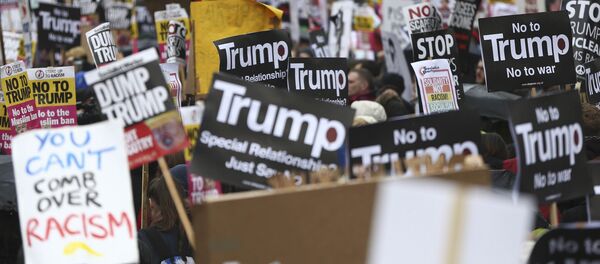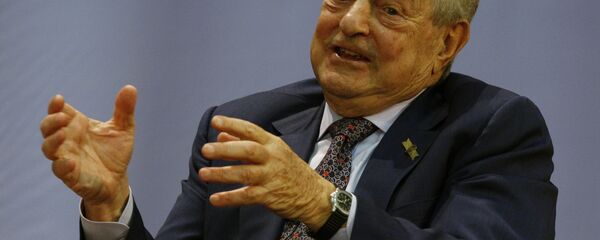On Thursday, Sputnik reported on billionaire financier George Soros' extensive secret spending on special interest groups meant to help keep the global anti-Trump protests going. "The source of funding for this unrest is important to note," Thursday's report emphasized, given that "organizations affiliated with the billionaire have been deeply connected to color revolutions and political uprisings across the globe, including the Arab Spring."
On Saturday, tens of thousands of protesters took to the streets of major cities across the US for the third weekend in a row, condemning Trump's agenda, his executive orders and his cabinet appointees. Protests rocked New York City, Washington, D.C., San Francisco and Los Angeles, with smaller demonstrations held in other cities and at US embassies in other countries.
Russian observers, well-acquainted with State Department's use of color revolution technology in countries near Russia in the past, have marked their surprise in seeing some of the formula's well-known methods being deployed in the US itself.
In a recent op-ed for RIA Novosti, Radio Sputnik contributor Svetlana Kalmikova suggested that when "one looks through the images of the fervent anti-Trump protests, one unwittingly starts to search among the pink caps for the severe-looking lady handing out cookies. And who knows, maybe she's already there among the masses."
"Serbia, Georgia, Kyrgyzstan, Ukraine, Lebanon, and the 'Arab Spring' in Tunisia, Egypt, Libya and Syria – the technology has been well tested," Kalmikova wrote.
"First, an issue or incident is chosen. In the case of the US, it's Trump's decree on immigration. The next step is to attract maximum attention to the issue from society, so that it becomes a headline in the news. And here the internal US issue is blown up by global media. Politicians from the EU, Asia and the Middle East rush to comment on the issue with conviction, and the US press eagerly quotes even those people whom they paid little attention to only yesterday."
"To drive their point home," the journalist added, "Trump's executive order is called 'anti-Muslim', and claims are made that it infringes on US rights and freedoms, and contradicts Western values, even if the issue is really about the threat of terrorism and national security."
And so, Kalmikova noted, the country "is filled with thousands of disgruntled representatives of the 'creative' liberal class, and they take to the streets, the same way it happened in other countries. Again, it's all presented as a spontaneous process…In reality, everything is well-orchestrated. The crowds are well-organized. Bright 'revolutionary' symbols are used for the purpose of separating friend from foe. They started with pink caps. In the future, something else may be added. The crowds are warmed up by opinion makers, including movie stars, musicians, directors, etc. All of this is very familiar."
"It's no accident," she noted, "that former President Barack Obama expressed his support for the protesters, and added that he was 'heartened by the level of engagement taking place in communities across the country.'"
After that, Kalmikova wrote that "traditionally, the next step is to issue threats against the legitimate authorities, and demand that they leave office."
In his own op-ed, political commentator Alexei Pankin recalled that from the first days following Trump's election, "efforts began to try to deprive him of his victory, from charges of electoral fraud, to calls for impeachment as an 'agent of the Kremlin'…After the inauguration, his opponents began murmuring something about the 25th Amendment of the US Constitution, which deals with mechanism to replace a president in the event that he is unable to fulfill his duties."
"All of this is unprecedented in American history," Pankin emphasized, and points to "classic signs of a color revolution, with dissatisfaction with election results by the active part of the losing side's electorate mixing with an elite conspiracy."
Trump, the analyst recalled, faces opposition from the "globalist-oriented part of both the Democratic and Republican establishment, from intelligence agencies, NGOs and, with a few exceptions, leading media. Influential world powers, including the leadership of the EU, Germany and France, are also on their side. We all remember the immensely important role played by international actors in the color revolutions in Yugoslavia, Georgia and Ukraine."
The Democrats, the observer noted, lost their chance at victory in the elections when they failed to nominate their own 'revolutionary' candidate, Vermont Senator Bernie Sanders. "Trump and Sanders are two sides of the same coin. Both are anti-globalists, both see solving internal problems as their main priority, both challenged the ruling parties and appealed to the under-privileged sections of the population," Pankin suggested.
Now, Russian observers warn, the biggest danger stems from the next step in the color revolution playbook: a provocation against police or other law enforcement agents, for example by 'unprovoked' violence by police against protesters which serves to further galvanize protesters' anti-government moods, and results in more demonstraters joining in.
This final step was most vividly (and brutally) demonstrated in Kiev in February 2014, when snipers (whose identity remains a mystery to this day) fired on protesters and police alike. Protest leaders then accused the government of extreme brutality, authorities lost their nerve, and a coup d'état followed. Hopefully, US officials are aware of the dangers of such an eventuality, and won't allow things to reach that point.





